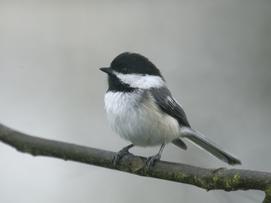CHICKADEE HYBRIDS MO-149
Prairie State Park, Mindenmines, Missouri
June 3, 5:43 a.m.
Sunrise at 5:58 a.m.
What a remarkable variety of songs this mixed-up chickadee sings! He is the kind of singer that one might expect to hear in a true hybrid zone between black-capped chickadees and Carolina chickadees.
In every song, one hears traces of typical black-capped chickadee songs (hey-sweetie) or typical Carolina Chickadee songs (with alternating high and low notes), or both.
Take the first song: He begins with a typical hey-sweetie, but then adds a second sweetie, lower than the first. The second song alternates hi and low elements like a typical Carolina chickadee song, but it's longer than expected, with six elements; the third song is the same, but adds part of a seventh element. He plays with those two song forms until 0:29, when he delivers a typical hey-sweetie of a black-capped chickadee, the entire song pitch-shifted from the hey-sweetie elements of before. So he has not only the song forms of the black-capped chickadee but the pitch-shifting behavior as well.
At 0:37, he combines a higher-pitched hey-sweetie of a black-capped chickadee with the alternating elements of a Carolina chickadee, all in one song, a clear hybrid song.
And at 0:54, as is evident in the sonagrams but not so easily to the naked ear, he introduces a second form of the hi-low song of a Carolina chickadee. Next (at 0:58) is the high note of a Carolina chickadee song followed by a typical hey-sweetie on a much lower frequency, another hybrid song.
At 2:42 is a beautiful hey-sweetie song, but then listen to the next song. It is a hi-lo-hi-lo version of a Carolina chickadee song, but the last low note is actually a double note, like a sweetie, so it's hi-low-hi-sweetie, yet another fine hybrid song.
He throws in a few gargle notes, too, notes that are given in aggressive encounters and often interspersed with the whistled songs during the dawn chorus (e.g., three times between 2:20 and 2:30).
What a bird! Standing in the contact zone between the ranges of the Carolina chickadee and the black-capped chickadee, this is exactly the kind of behavior that I have read I should encounter here.
Background
Eastern towhee, tufted titmouse (repeating the same song throughout), yellow-billed cuckoo, blue jay.

Photo by John Van de Graaff
